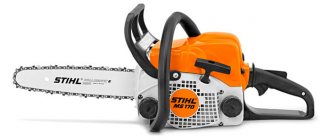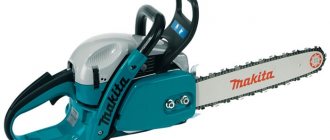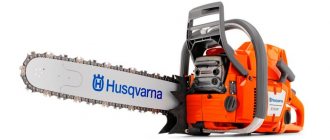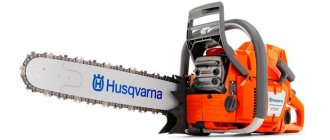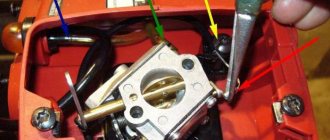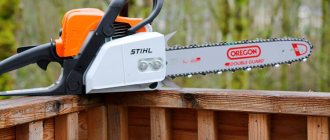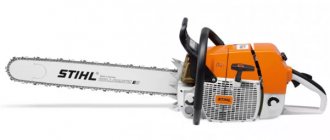How to adjust the carburetor on a chainsaw - all the secrets of the correct settings
Stable, stable operation at any speed, developed power, efficiency, use of technical capabilities to the extent provided and laid down by the manufacturer, and even the service life of the chainsaw - all this depends on its carburetor.
In addition to the fact that this unit must also be kept in proper condition and serviced in a timely manner, it must also be correctly adjusted. Adjusting the carburetor of a chainsaw is not an easy task, but with a leisurely, thoughtful approach and strict adherence to the instructions, almost anyone can do it, and it should be done at the first sign of the need for this, regardless of whether the chainsaw is in use new or well-worn. The need to adjust the fuel supply unit (hereinafter referred to as the FSU, that is, the carburetor) is indicated by the following reasons, symptoms and malfunctions:
- factory or own settings were lost due to loosening of the adjusting bolts and vibration, or during unsuccessful attempts to adjust the carburetor again;
- the UPT housing cover is damaged;
- the engine does not start or starts with difficulty, and then stalls almost immediately;
- the saw does not operate steadily at idle or does not hold it at all;
- excessive fuel consumption and too thick exhaust;
- spark plug electrodes are black (supply of an over-rich mixture to the engine) or with a white coating (lean);
- the chain saw does not develop maximum speed or power;
- the engine stalls while gaining speed;
- there is strong vibration of the chainsaw;
- due to malfunctions in the air purification system, debris particles got into the mechanism distributing the air-fuel mixture;
- the piston group has significant wear - in this case, adjustment of the UPT is used as a temporary measure to make the operation of the tool more stable.
Naturally, if dirt gets into the fuel system, it needs to be flushed - adjusting the carburetor cannot solve this problem. And a worn piston needs major repairs. However, in these cases, too, adjustments are made.
Adjusting the chainsaw carburetor
It may also be necessary to adjust the UPT even if there is a change in the brand or quality of fuel, atmospheric pressure, humidity and ambient temperature, altitude above sea level (when the place of operation changes from a plain to a mountainous area, then due to rarefaction of air, and vice versa).
Before adjusting the UPT, you must make sure that both filters (air and fuel) are clean. In addition, there should be no air leakage into the engine from the side (through the seals, the gasket under the UPT or its accelerator pump, or anywhere else), otherwise it will not be possible to adjust the carburetor.
Preparing to adjust the carburetor
Almost any UPT is adjusted with 3 screws:
- 1. The main jet bolt, designated "H" and used to set the maximum speed of the saw motor.
- 2. Idle jet bolt, designated “L” and used to set low speed. That is, to regulate idle speed.
- 3. Idle speed adjustment bolt, designated in various cases, “LA” (Stihl), “T” (Partner, Husqvarna).
There are also carburetors with fewer adjustment screws. In this way, manufacturers protect their products from unprofessional intervention and at the same time try to simplify their setup.
Before you begin the adjustment, you should carefully study the operating instructions supplied with the chainsaw, especially the part where the angles of rotation of the adjusting bolts are given. This is an important condition that will allow you to configure it correctly without going beyond the operating parameters of the engine.
For safe regulation during its implementation, the following rules should be followed:
- 1. The tool must be firmly installed on a flat surface of a rigidly fixed object (workbench, rack, table).
- 2. The chain should be directed away from yourself and others present.
- 3. There must be a safe distance between the chain and any surrounding objects to ensure that they cannot come into contact with each other.
In such cases, you can adjust the carburetor on a chainsaw as follows. First, we start the tool and warm it up for 10 minutes.
We begin adjusting the UPT by determining the position of the adjusting screw “L”, at which the idle speed will be the highest. To do this, very slowly and smoothly turn this bolt in one direction, then in the other. And so on several times until the desired position is found. After this, turn “L” 1/8–1/4 of a turn (the required value is indicated in the technical documentation for the tool) counterclockwise (hereinafter referred to as FC).
Then we continue adjusting the idle speed using the screw “S” (“LA”, “T”):
- If the chain is motionless after manipulating the bolt “L”, then you need to smoothly rotate “S” (“LA”, “T”) clockwise (hereinafter referred to as POCHS) until it starts to move. Then we tighten the “S” 1/8–1/4 turn back.
- If the chain moves, rotate “S” (“LA”, “T”) of the frequency control unit until it stops, and then twist “S” 1/8–1/4 turn in the same direction.
The engine should run smoothly. And we check it, how it accelerates. It is considered that the engine is working normally in acceleration mode if, when you smoothly press the accelerator, the speed increases to its maximum value in a short time and without “dips.” If the engine runs unevenly and/or accelerates poorly, then you need to slightly - a maximum of 1/8 of a whole turn - turn the “L” of the CV joint. After this, you must again make the above adjustment “S” (“LA”, “T”). We repeat these adjustments until the engine runs smoothly and accelerates well.
Checking the operation of the chainsaw
Now we check the setting of the adjusting bolt “H”. To do this, we accelerate the engine to maximum speed. You just can’t drive it for a long time without load, you have to take breaks. We look at the exhaust and listen to the operation of the engine. If too much bluish smoke comes out of the muffler, and the chain saw makes a lot of noise, it means the carburetor is making the mixture too rich. In addition, the maximum speed of the power unit is lower than it should be. And also carbon deposits will form in it. In this case, it is necessary to tuck the “H” slightly. Then we check the operation of the engine again and, if necessary, repeat the adjustment.
When the chainsaw makes a squealing sound, the engine gets very hot, the exhaust is accompanied by a crackling sound and/or misfires are heard, that is, detonation is occurring - the mixture is too lean, and the maximum engine speed is higher than it should be. This leads to overheating of the power unit, burnout of the piston, rapid wear of the cylinder and burnout of the spark plug. In this case, you need to turn “H” 1/4 turn.
To complete the adjustment, check the saw at idle speed. With a correctly adjusted UPT, it should work like this:
- 1. The chain is stationary.
- 2. The engine sounds almost like a four-stroke.
- 3. Pressing the accelerator leads to a rapid increase in maximum speed.
If these conditions are not fully met, you should use “S” (“LA”, “T”) as indicated above, or repeat the setting from the very beginning.
This is how an approximate adjustment is made. For accuracy you need a tachometer. We do the same thing, only we turn the adjusting bolts, focusing on the readings of this device. This will allow you to accurately and, most likely, adjust the carburetor the first time, achieving, depending on the model of the tool for working with wood, an idle speed setting of 2800–3300 rpm or higher and a maximum speed of 11000–15000 rpm. Which ones should be set should be looked at in the technical documentation (operating instructions) for the saw.
After maintenance, such as disassembly and washing, or previous unsuccessful attempts to adjust, this unit may become completely out of alignment. So much so that the chain saw will not start at all. In this case, it is necessary to configure the engine power system in 2 stages, conventionally called:
- basic – with the engine not running;
- final - performed on a warm engine.
When adjustment may be needed
With proper use, a good Stihl one hundred and eighty chainsaw (or any other) should serve you for a long time. How to properly start a Chinese Stihl 180 chainsaw. But everything happens
The most common reasons:
- Loose mounting screws
- The engine was worn out (in this case, adjusting a chainsaw like Goodluck or Sturm will only help temporarily, ideally it is better to immediately take it for repairs)
- The carburetor is clogged (in this case it will also have to be cleaned).
Setting up a chainsaw carburetor. Or how not to pay repairmen!
Owning a chainsaw makes life easier even for an amateur in many ways, and in some professions this tool is actually indispensable. However, like any relatively complex device, a chainsaw requires periodic maintenance. Due to untimely or poor quality maintenance, as well as as a result of exposure to both planned and excessive loads, various types of malfunctions may appear. For professionals, interruptions or unstable operation of the saw reduce work efficiency or can cause a ruined work day. One of the quite common malfunctions is the incorrect setting of the chainsaw carburetor, which gets lost due to unsuccessful attempts at adjustment or displacement of the adjusting screws for other reasons.
The chainsaw is flooded. What to do?
Very often, after selling a chainsaw, we are faced with a problem. A confused customer stands on the threshold of the store with a chainsaw in his hands and complains that the saw will not start and that he was sold a low-quality tool.
Everything turns out to be not as scary as it might seem at first glance. The spark plug is simply flooded and the chainsaw cannot start.
Why the spark plug on a chainsaw floods: reasons
The key reason for a flooded spark plug on a gasoline saw is an increased amount of fuel in the combustion chamber and this can be caused by various reasons, in particular:
- Poor quality gasoline.
- A clogged air filter that no longer copes with its function.
- Ignition system failure.
- The carburetor is not adjusted.
- Incorrect actions when starting the saw.
But since in our case the saw was new, we most likely encountered point No. 5.
Most often this happens to beginners when, when starting for the first time, they miss the moment of setting on the closed carburetor valve and continue to pull the starter handle. Accordingly, there is a lot of gasoline in the combustion chamber, and a small amount of air prevents the gasoline from igniting.
Today we will look step by step what to do if we missed the setting moment and cannot start the saw. We will look at the example of the Shtil MS-180 chainsaw.
Symptoms of malfunctions and breakdowns that require carburetor adjustment.
The following signs and malfunctions indicate the need to adjust the carburetor:
- the engine starts with effort and stalls almost instantly;
- gasoline consumption is excessively high, the exhaust is too thick, the combustible mixture in the cylinder does not burn completely;
- the factory settings of the chainsaw carburetor are lost (due to vibrations or unsuccessful attempts at adjustment);
- malfunctions of the air purification system, which led to the entry of debris into the fuel mixture distributing mechanism;
- significant wear of the piston group - carburetor adjustment in this case acts as a temporary measure.
It is clear that if dirt gets into the fuel system, one adjustment alone will not solve the problem - it needs to be flushed. If the piston is worn out, a major overhaul is required. However, in all these cases, the carburetor is also adjusted.
Do-it-yourself troubleshooting
If you do the troubleshooting yourself, you need to make room and arrange small parts. Tool required:
- brush;
- screwdriver for cross-threaded heads;
- socket wrench or M6 head;
- pure gasoline.
The main thing is to properly release the unit from the installation site, cleaning the outside of it from dirt. The air intake is removed, opening access to the carburetor and choke rod. Remove the accelerator lever by lowering the carburetor choke. Release the part by removing the choke lever, lifting the wire along with the lever towards you, hooking it on the left.
Rinse the freed carburetor in gasoline, blow it with air, clean the grille by injecting it with a thin needle.
When reassembling the assembly, make sure that the spring under the needle lever is in place. If you forget it, the fuel is not cut off, the spark plug is damp and does not produce a spark.
It happens that the gas button sticks slightly. In this case, it is necessary to clean the throttle from deposits. After cleaning, it is necessary to protect the damper with tinning.
After assembling the carburetor, installing it in place, make adjustments as described above.
Video instructions for adjusting the carburetor of a chainsaw
Carburetor adjustment
do it yourself with a chainsaw
Adjusting the carburetor of the Husqvarna saw.
For the running-in mode, so that the parts receive sufficient lubrication, the carburetor of the Husqvarna chainsaw is adjusted so that the maximum speed is 600–700 rpm. below working. If it is not possible to set the operating maximum frequency using the tachometer, you should not change the preliminary settings with screw H. The manufacturer is prohibited from exceeding the maximum number of revolutions. If, after completing the adjustment, the saw chain moves when the engine is idling, turn screw T counterclockwise to force it to stop completely.
For precise adjustment, the saw must be warmed up for at least 10 minutes and placed on a flat surface. The tire should be directed in the opposite direction from the person performing the adjustment. At the initial stage, the highest value of the idle speed should be detected. To do this, screw L is smoothly turned, first from left to right, then vice versa. When the maximum speed has been found experimentally, screw L should be turned counterclockwise by a value from 1/8 to a quarter of a full turn.
The idle speed is adjusted using a jet marked with the letter T. It must be turned from left to right until the chain begins to move. Then move smoothly in the opposite direction until the chain stops rotating. Screw H is considered to be installed correctly if the operating noise of the saw at full throttle without load remains small. If the exhaust is too smoky and the saw makes a lot of noise, the mixture is too rich. You need to turn the jet H clockwise until the correct sound is achieved. You can see how to properly adjust the carburetor in the video below.
Basic operating rules
In order for the tool to serve you for a long time without breakdowns, you should remember the basic rules of use:
- According to the instructions, immediately after purchase the tool must undergo a break-in period to grind in all parts. The approximate break-in time is up to 15 full used gas tanks.
- For refueling, use only high-quality gasoline (A-92 or A-95), as well as original Shtil oil.
- Before starting work, check the presence of lubrication and the degree of chain tension.
- Do not increase the speed while the chain brake is engaged to avoid damaging the drive or clutch.
Following these simple rules will help to significantly extend the life of your saw and protect it from premature repairs.
source
Chainsaws Partner and Shtil, their adjustments.
In Shtil and Partner chainsaws, adjusting screws H and L set the proportion of air and gasoline in the mixture. When the screws are loosened, the mixture becomes richer and the speed increases. Screwing leads to a leaner mixture and, accordingly, a decrease in engine speed.
Setting the carburetor of the Partner chainsaw to idle speed is carried out using screw T (Shtil marks this adjustment with the letters LA). Basic tool adjustment is done at the factory during final testing. In most cases, the carburetor is adjusted to supply a slightly richer air-fuel mixture than the optimal calculated one. The settings set by the manufacturer must be saved during the first few hours of operation, during the break-in period. After this, finer adjustments can be made, although this is not necessary; the saw will work normally at the basic settings.
For fine adjustment of the carburetor, a tachometer is required, in addition, technical documentation will be needed in order to carry out work in strict accordance with the manufacturer's requirements. The best solution would be to entrust the fine tuning of fuel equipment to specialists.
If you still decide to adjust it yourself, you should start with screw L, then move on to jet H, after which you set the idle speed by rotating screw T (or LA - if it’s a Stihl saw).
By smoothly turning screw L in both directions, a position is sought at which the idle speed will be maximum. Once this point is found, you need to unscrew screw L 1/4 turn. If the chain continues to move while the engine is idling, screw T (LA) is slowly unscrewed until the chain stops.
After setting the maximum speed with screw H, the value of their frequency is checked using the tachometer. If the maximum rotation speed does not correspond to the values specified in the documentation, the adjustments are repeated. If at maximum speed the mixture is too rich, too much smoke comes from the muffler; if the mixture is lean, the saw makes a squealing sound and the engine heats up excessively. The adjustment ends with setting the idle speed - the position is considered correct if the engine runs exactly at minimum speed and the chain is stationary. The idle speed setting can be seen in the video below.
Features of do-it-yourself adjustment
The adjustment occurs in two stages.
- The first setting
is the basic (factory) setting, carried out with the engine turned off. - The final test
is performed with the engine running and fully warmed up. To accurately determine the values of rotation angles, especially in a Ural chainsaw, it is necessary to use data from the operating instructions for a specific tool.
The adjustment is performed using clean fuel and air filters. Most carburetors are adjusted using three screws: maximum and minimum speed, as well as idle speed.
- L
– used for low speed settings; - H
– allows you to configure at high speeds; - T
– belongs to the visible category and regulates idle movement.
Setting up the carburetor of a Chinese chainsaw
Almost any Chinese chainsaw has the same adjustments as its branded counterparts. The same screws L, H and T are present. Sometimes there are saws in which only the idle speed can be adjusted. However, according to reviews from owners and service workers, not every chainsaw can be adjusted without problems. Even for experienced repairmen, some models can take a decent amount of time before getting an acceptable result.
The standard position for “Chinese” carburetors is the position of the screw L, at which it is loosened by one and a half turns from the fully clamped position. For screw H - one revolution from the same state. In many videos, screw L is called adjusting the quality of the mixture, and screw H is its quantity. The idle speed is adjusted in the same way as described above on a warm engine.
Chinese models
Adjusting the carburetor of a Chinese chainsaw, for example, Carver, is carried out in almost the same way as factory models. There are the same three main adjustment screws L, N, T. Sometimes such models have the ability to adjust the idle speed. But as a rule, employees of specialized services and owners of such saws claim that it is not always possible to set up a high-quality Chinese chainsaw right away.
For classic Chinese models, screw L should be loosened 1.5 turns from the maximum value. Screw H must be loosened one revolution from the maximum. Idle speed is adjusted in the same way.
Thus, self-adjustment of a chainsaw carburetor is not a very complicated process and can, in most cases, be done by a self-taught person.
Adjusting the chainsaw carburetor.
Why might it be necessary to adjust the carburetor even if it seems to start and work? Carburetor adjustments must be optimal.
In general, the carburetor has a very important influence on the operation of the chainsaw; it is its “brain”, indicating how much air and fuel mixture to supply into the cylinder and in what proportion. If the mixture is “rich”, that is, there is more fuel in it than required, then as a result we have a loss of power, deposits on the cylinder walls and piston. Which in turn can lead to failure of the chainsaw. In turn, a “lean” mixture, which contains more than normal air in its composition, also leads to loss of power, insufficient lubrication of the CPG, scuffing and possible “jamming” of the engine. Optimal settings for a chainsaw carburetor allows you to get maximum power, extend engine life, and ensure minimal emissions into the atmosphere!
Throttle valve
The throttle valve is installed in the carburetor body and is responsible for increasing the flow of the fuel mixture directly into the engine cylinder. When you press the gas, the throttle valve opens slightly, thereby increasing the throughput of the channel, and fuel from the carburetor cavity enters the cylinder in a larger volume.
The carburetor air damper is located at the rear of the throttle body and is responsible for starting a cold engine and is controlled by the engine control lever. For cold starts, the air damper is closed one hundred percent; for normal work it is open.
But I want to warn you, be careful when adjusting the carburetor. Therefore, both leaning and enriching the fuel mixture and playing with the speed of revolutions, this has very serious consequences.
Adjusting the chainsaw carburetor
Most chainsaws have three adjustment screws on the carburetor. In order about each:
- T - Idle screw. The idle screw is responsible for the position of the throttle valve when the throttle handle is completely released. If the throttle valve is not open enough, the engine will stall when the handle is released because the throttle valve will cut off the supply of the fuel mixture. If the throttle valve is opened more than it should be, then the chain will rotate, which is strictly prohibited by safety precautions when working with a chainsaw.
- L-Low speed adjustment screw. This screw regulates the amount of fuel in the fuel mixture when the chainsaw is idling. If the amount of fuel is large, the engine will stall under load; if there is not enough fuel, the result will be engine overheating, scuffing, and so on...
- H-High speed adjustment screw. Responsible for the amount of fuel in the mixture when the chainsaw is operating. If this adjustment is set to a larger amount of fuel, then the engine runs “unacceptably” and smokes, and if it is set to a smaller amount, then we get too high speeds and overheating.
Carburetor adjustment step by step
- Check the condition of the air filter. We remove it and either clean it or change it. If the air filter is clogged with dirt and sawdust, the chainsaw will not operate normally.
- We check the condition of the muffler. It must be clean and unclogged. Read more about cleaning the muffler HERE.
- Before you start adjusting the carburetor, you should fill the fuel tank at least halfway.
- If the chainsaw is able to start, then you should let it run for a few minutes to warm up. If the adjustment is carried out “cold”, then the mixture will be over-rich after warming up.
- You need to start adjusting by adjusting the idle speed - screw L. It is highly advisable to have a tachometer, then we focus on 2700 rpm. If not, then we need to find the highest idle speed. In this case, the chain should not rotate. If it still spins (the chain, of course, and not the Earth), then we stop it by rotating screw T. The sound of the chainsaw should be the same as when listening to the file below. https://benzopilatut.ru/wp-content/uploads/2016/01/Chainsaw-at-idling.wav
- We regulate high revolutions - screw H. If we rotate it clockwise, the revolutions will increase, and if counterclockwise, they will fall. We tighten it until failures appear in the ignition. After that, turn it out about one-fifth of a turn. The sound of a chainsaw when operating at maximum speed should be like this when listening to the file below. https://benzopilatut.ru/wp-content/uploads/2016/01/Chainsaw-maximum-speed.wav
- Let's check how the chainsaw is gaining momentum. She should type them smoothly and quickly. If the speed increases slowly, then turn out screw L slightly.
If you have any questions, write in the comments or better in the VK group.
Remember that the optimal carburetor adjustment is:
Operating principle
The purpose of the carburetor is to prepare the working mixture for supplying it to the engine cylinders. This mixture is gasoline and air in the proportions required for engine operation. If this ratio is violated, the engine will not operate smoothly. When the mixture has a lot of gasoline, then in layman's terminology it is called saturated, and if, on the contrary, there is little, then it is lean. But in any case, a failure in the proportions of the working mixture will have a bad effect on performance.
Different models of chainsaws may have different carburetor designs, but according to the principle of operation they are all identical. Air moves through a special channel at a speed that can be adjusted by closing or opening the damper. Gasoline, in turn, enters the carburetor through jets and mixes with air there, creating a special mixture that enters the engine.
The pressure in the float compartment of the carburetor, where gasoline is present before mixing, is close to atmospheric. When the damper is opened, there is more air, as well as gasoline, due to which the engine speed increases. This creates a vacuum in the air channel and gasoline is drawn into the air flow. This is the principle of operation of a carburetor.
.
In order for the chainsaw to operate smoothly and efficiently, and also without high fuel consumption, its carburetor must be adjusted accordingly. Before such work, you must first check the air and gasoline filters. If dirt is found on them, they should be replaced.
Setting up a chainsaw for most models is usually done using three screws - high and low speed and idle speed.
The following signs should indicate correct configuration:
- The chain should not move at idle.
- The motor runs smoothly.
- There should also be no interruptions in work at start-up.
Repairing a chainsaw carburetor with your own hands must be done very carefully, because any mistake made can lead to serious consequences, even to the point of complete engine failure. If you do not have enough experience, it is better to seek the help of a specialist.
.
Chainsaw Stihl 211: characteristics, features
With each new modification, chainsaws from the German brand Stihl provide owners with an improved design and excellent performance. Shtil 211 chainsaws occupy their place in the lineup, which, for some reason, are completely undeservedly deprived of attention by users. Manufacturers created this saw, taking into account all the disadvantages of previous developments, as well as the wishes of customers. Stihl 211 is quite light, productive, and economical. The tool belongs to the household category, but its design and capabilities allow it to solve quite difficult tasks, which makes this saw necessary for any private household.
Sore spots Shtil 180
Every instrument has problems and the 180 is no exception, but the most painful place is the 100% air filter. Replacement filter element 180 - open "G".
Why the Germans don’t change the design and put a multi-use mesh filter on this model instead of a piece of something unknown, through which all the garbage flies into the carburetor, only God knows. Maybe this was done on purpose?
Well, the filter needs to be changed regularly. I don’t recommend washing it to anyone, because... after that it loses its shape and may leak at the joints with the body.
The second problem is the crankshaft seals. Many times I was faced with a situation where, even if the bearings were in good condition, the seals poisoned, air got into the crankcase, the maximum speed increased, with all the consequences, even to the point of scuffing the piston. Whether it is a manufacturing defect or operating conditions, the fact remains that oil seals often cause serious problems with the engine.
Scope and design of the Stihl 211 chainsaw
The use of the Stihl 211 chainsaw is quite extensive.
It is used to collect firewood, saw wood for household or construction purposes, and trim trees in the garden. The characteristics of the saw allow you to cut trees with a trunk diameter of about 30 cm. Any type of work with this saw can be carried out safely and comfortably due to the improved design and balancing of the entire tool, conveniently located handles, and an effective emergency brake. Unlike similar tools from other brands, the Shtil MC 211 chainsaw has a reliable vibration protection system. There is also a filter with air pre-cleaning and a fuel consumption reduction system. Environmental friendliness during operation of the saw is ensured by the 2MIX system, which significantly reduces the amount of harmful substances in the exhaust gases.
This modification, compared to earlier Shtil models, has such improvements as a quick start system (ErgoStart), a convenient mechanism for adjusting chain tension. The capabilities of the saw can also be expanded by installing a specially designed carbide chain, the working life of which is increased by 4 times.
Design and principle of operation
The Stihl MS 361 chainsaw carburetor consists of 42 parts, including gaskets and mounting screws. Main nodes:
- housing with air and fuel supply channels, storage chamber;
- diffuser;
- jets;
- air and throttle valves;
- membrane;
- manual fuel pump (primer).
Fuel from the gas tank enters the carburetor, where it is atomized, mixed with air, and the resulting fuel-air mixture is fed into the combustion chamber. A mixture with a higher gasoline content is called enriched. If there is more air and less air, the mixture becomes lean. The composition of the mixture is adjusted using adjusting screws. The carburetor is considered a complex device because it ensures the operation of the internal combustion engine in three different modes - cold start, idle and at maximum speed.
After starting, a vacuum is formed in the combustion chamber during operation of the internal combustion engine, into which the fuel-air mixture is automatically sucked in.
At idle, the throttle valve is closed, and the flow of mixture is limited.
When you press the gas handle, the throttle valve opens slightly, the mixture supply and engine speed increase.
Out of habit, the storage tank is sometimes called a “float chamber,” although there is no float in membrane carburetors.
In the “full throttle” position, the throttle and air valves are fully open. The flow of gasoline in this mode is regulated only by a calibrated hole in the high-speed nozzle. When adjusting, adjusting screw H can reduce or increase the flow of gasoline through this hole. Screws L and LA regulate idle and low speed.
External view of the carburetor of the Shtil MS 361 chainsaw
Features and technical characteristics of the Shtil 211 saw
The reliability and performance of this chainsaw is ensured by high-quality materials and workmanship.
The main working parts are made of forged steel, the cylinder is chrome-plated, the plastic of the protective casing is strong and designed for high loads. The basic modification of the Stihl MS 211 14 chainsaw has a two-stroke engine running on a mixture of gasoline and oil. The proportion is standard for 2-stroke engines - the ratio of gasoline to oil is 50:1.
The tool also has the following technical characteristics:
- power – 2.3 l. With.;
- chain pitch - 3/8 inch;
- chain thickness – 1.3 mm;
- number of chain links – 50;
- fuel tank capacity – 270 ml;
- tire length – 35 cm;
- weight – 4.3 kg.
Another modification of the Stihl MS 211 16 chainsaw differs only in the increased length of the bar, which is 40 cm.
